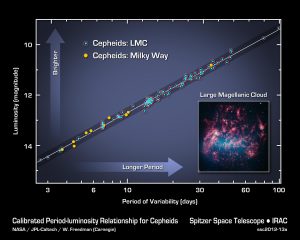A Cepheid variable is a member of a class of very luminous stars. The direct relationship between the luminosity of a Cepheid variable and its pulsation period provides astronomers with a standard candle for establishing vast galactic and extragalactic distances. They can be used to measure distances from about one kiloparsec to 50 megaparsecs. To put that into perspective one parsec equals 3.26 light years: 1kpc = 3 260 light years; 1 mpc = about 3.3 million light years. If that doesn’t sound a lot try this: 1mpc = 30 841 989 trillion kilometres.

Cepheid variables are divided into several sub-classes, which exhibit markedly different masses, ages, and evolutionary histories: Classical Cepheids, Type II Cepheids, Anomalous Cepheids, and Dwarf Cepheids.
Over 800 have been found in our galaxy. The term “Cepheid” originates from Delta Cephei in the Constellation Cepheus, the first star of the Classical Cepheids to be identified by English amateur astronomer John Goodricke (1764-1786) in 1784. Delta Cephei is of particular importance as a calibrator of the Cepheid period-luminosity relation since its distance is among the most precisely known for this type, thanks in part to its membership of a star cluster and the availability of precise Hubble Space Telescope/Hipparcos parallaxes.
Classical Cepheids are yellow supergiants in spectral classes F6 to K2. They are 4 to 20 times more massive than the sun, and up to 100 000 times more luminous. During each pulsation cycle their diameters can expand by as much as 25%. The bigger the star the longer this takes. By comparing the period between maximum and minimum brightness astronomers can determine its mass.
Pioneering work by Henrietta Leavitt lay the foundation work for correlating the distance of Cepheid variables. At the time she had no way of determining the distance to the two Magellanic Clouds she was studying, just that there was a distinct relationship between luminosity and distance. Once the distance to the Magellanic Clouds had been agreed upon then it was a simple matter to use Leavitt’s Period Luminosity Law to determine the absolute magnitude of the Cepheid variables. This meant that if you found a Cepheid variable anywhere in the universe then you could determine the distance to objects and features in its region.
So look for a Classical Cepheid variable anywhere in the universe, measure its luminous period of variation and you have its distance from Earth.
Examples of Cepheid variables:
- Classical Cepheids include: Beta Doradus, Eta Aquilae, Polaris, RT Aurigae, and Zeta Geminorum, as well as Delta Cephei. The North Star (Polaris) is the closest Classical Cepheid, although the star exhibits many peculiarities, and its distance is a topic of active debate.
- Type II Cepheids include: BL Herculis and W Virginis.
- Dwarf Cepheids include: AI Velorum, Delta Scuti, and SX Phoenicis
Classical Cepheids are used to determine distances to galaxies within the Local Group and beyond and are a means by which the Hubble constant can be established. They have also been used to clarify many characteristics of our galaxy, such as the Sun’s height above the galactic plane and the galaxy’s local spiral structure.
Using Type Ia Supernovae to Measure Distance
While stellar parallax can only be used to measure distances to stars within hundreds of parsecs, Cepheid variable stars can be used to measure larger distances such as the distances between galaxies. However, interestingly certain supernovae can also be used to measure such large distances.
Type Ia supernovae are caused by exploding white dwarfs and they all have companion stars. They can be distinguished from other supernovae because they do not have hydrogen lines in their spectra but have a strong silicon signature.
All type Ia supernovae reach nearly the same brightness at the peak of their outburst with an absolute magnitude of -19.3. They then follow a distinct curve as they decrease in brightness. So when astronomers observe a type Ia supernova, once they know its absolute magnitude, they can measure its apparent magnitude. This allows them to calculate the distance to the event. And by observation the distance to any other object in the vicinity.
Supernova
In the case of a supernova the same process takes place. However, the material transferring to the white dwarf continues to amass to such an extent that the star finally collapses and then explodes destroying itself. There are various types of supernova. For example, in type Ia the collapsing core triggers the fusion of carbon and oxygen, which results in a massive explosion and a huge increase in luminosity. Astronomers have discovered that all supernovae display the same luminosity. This allows them to calculate the distance to the supernova by comparing its intrinsic luminosity with its apparent brightness.
[Supernova is further discussed in the section: Stellar End Points]
Nova
A nova is a binary system, consisting of one giant star that is being orbited by a smaller white dwarf. Because the giant is so big its gravity is unable to maintain its outer materials, which instead migrate to the white dwarf, increasing its mass. When this exceeds 1.44 solar masses the dwarf becomes unstable and it undergoes a catastrophic explosion that creates a massive increase in brightness. Early astronomers thought this was the birth of a new star, hence the term “nova”. But the reality is that a nova is the death of a star.
At maxima novae have continuous spectra with the greatest intensity in the ultra-violet range. Novae are classified according to the speed at which their brightness changes:
- Type-Na experience the most rapid change
- Type-Nb are slower
- Type-Nc are very slow
- Type-Nd are repetitive.
By Nigel Benetton, science fiction author of Red Moon Burning and The Wild Sands of Rotar.
Last updated: Tuesday, 2nd March 2021